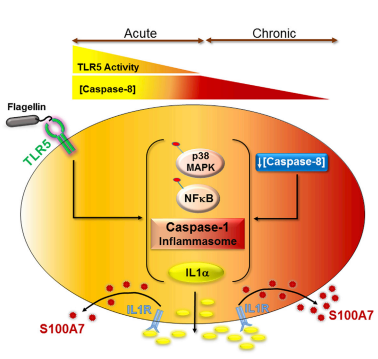Sandbox Reserved 1111
From Proteopedia
(Difference between revisions)
| Line 16: | Line 16: | ||
Some S100 proteins such as S100A7 are clearly overexpressed in psoriasis, wound healing, skin cancer, inflammation, cellular stress and other skin conditions. | Some S100 proteins such as S100A7 are clearly overexpressed in psoriasis, wound healing, skin cancer, inflammation, cellular stress and other skin conditions. | ||
Human psoriasin is highly expressed in hyperproliferative skin conditions such as [https://en.wikipedia.org/wiki/Atopic_dermatitis Atopic_dermatitis] and [https://en.wikipedia.org/wiki/Psoriasis Psoriasis] <ref> S Alowami, G Qing, E Emberley, L Snell & PH Watson (2003). "Psoriasin , (S100A7) expression is altered during skin tumorigenesis" ''BMC Dermatology''.'''3'''(1): </ref> which causes a disruption of the skin barrier. In those conditions, scaling occure frequently on joints, like elbows and knees. Psoriasis is a genetic disease that disrupts cell division in skin cells. In a normal epidermal strcucture, [https://en.wikipedia.org/wiki/Keratinocyte keratinocytes] have a regulated process of differentiation. In psoriasis, this differentiation process is disturbed. S100A7 interracts with various signalling proteins and promotes the [https://en.wikipedia.org/wiki/Endothelium endothelial cells] proliferation. The exact role of the protein in psoriasis has not been found yet but its overexpression is thought to be a cause of the perturbation of the differentiation process of keratinocytes. <ref> AK Ekman, J Vegfors, C Bivik Eding, C Enerbäck (December 2016). "Overexpression of Psoriasin (S100A7) Contributes to Dysregulated Differentiation in Psoriasis", ''Acta Derm Venereol''. '''97''': https://www.medicaljournals.se/acta/content/html/10.2340/00015555-2596 </ref> | Human psoriasin is highly expressed in hyperproliferative skin conditions such as [https://en.wikipedia.org/wiki/Atopic_dermatitis Atopic_dermatitis] and [https://en.wikipedia.org/wiki/Psoriasis Psoriasis] <ref> S Alowami, G Qing, E Emberley, L Snell & PH Watson (2003). "Psoriasin , (S100A7) expression is altered during skin tumorigenesis" ''BMC Dermatology''.'''3'''(1): </ref> which causes a disruption of the skin barrier. In those conditions, scaling occure frequently on joints, like elbows and knees. Psoriasis is a genetic disease that disrupts cell division in skin cells. In a normal epidermal strcucture, [https://en.wikipedia.org/wiki/Keratinocyte keratinocytes] have a regulated process of differentiation. In psoriasis, this differentiation process is disturbed. S100A7 interracts with various signalling proteins and promotes the [https://en.wikipedia.org/wiki/Endothelium endothelial cells] proliferation. The exact role of the protein in psoriasis has not been found yet but its overexpression is thought to be a cause of the perturbation of the differentiation process of keratinocytes. <ref> AK Ekman, J Vegfors, C Bivik Eding, C Enerbäck (December 2016). "Overexpression of Psoriasin (S100A7) Contributes to Dysregulated Differentiation in Psoriasis", ''Acta Derm Venereol''. '''97''': https://www.medicaljournals.se/acta/content/html/10.2340/00015555-2596 </ref> | ||
| - | The study of S100A7 as well as S100 is therefore of great interest in the search for treatments for epidermal diseases. | + | The study of S100A7 as well as all of the S100 proteins is therefore of great interest in the search for treatments for epidermal diseases. |
== Antimicrobial Effect == | == Antimicrobial Effect == | ||
Revision as of 21:19, 17 January 2020
| This Sandbox is Reserved from 25/11/2019, through 30/9/2020 for use in the course "Structural Biology" taught by Bruno Kieffer at the University of Strasbourg, ESBS. This reservation includes Sandbox Reserved 1091 through Sandbox Reserved 1115. |
To get started:
More help: Help:Editing |
1 PSR
| |||||||||||
References
- ↑ Sedaghat F, Notopoulos A (October 2008). "S100 protein family and its application in clinical practice". Hippokratia. 4: 198-204. https://www.ncbi.nlm.nih.gov/pmc/articles/PMC2580040/pdf/hippokratia-12-198.pdf
- ↑ Eckert R, Broome AM, Ruse M, Robinson N, Ryan D, Lee K (July 2004). "S100 Proteins in the Epidermis". Journal of Investigative Dermatology. 123(1): 23-33.https://doi.org/10.1111/j.0022-202X.2004.22719.x
- ↑ Hagens G, Masouyé I, Augsburger E, Hotz R, Saurat JH, Siegenthaler G (April 1999) "Calcium-binding protein S100A7 and epidermal-type fatty acid-binding protein are associated in the cytosol of human keratinocytes" Biochem J. 339(2): 419-427: https://www.ncbi.nlm.nih.gov/pmc/articles/PMC1220173/
- ↑ Chmurzyńska A (March 2006). "The multigene family of fatty acid-binding proteins (FABPs): Function, structure and polymorphism".Journal of Applied Genetics.47(1): 39-48.https://link.springer.com/article/10.1007/BF03194597
- ↑ Brodersen DE, Etzerodt M, Madsen P, Celis JE, Thøgersen HC, Nyborg J, Kjeldgaard M (April 1998). "EF-hands at atomic resolution: the structure of human psoriasin(S100A7) solved by MAD phasing". Structure.6: 477-489.https://www.cell.com/structure/pdf/S0969-2126(98)00049-5.pdf
- ↑ Murray J, Boulanger M (April 2010). "S100A7 (S100 calcium binding protein A7)". Atlas of Genetics and Cytogeneticsin Oncology and Haematology. 15(1): 59-64. : http://AtlasGeneticsOncology.org/Genes/S100A7ID42194ch1q21.html
- ↑ S Alowami, G Qing, E Emberley, L Snell & PH Watson (2003). "Psoriasin , (S100A7) expression is altered during skin tumorigenesis" BMC Dermatology.3(1):
- ↑ AK Ekman, J Vegfors, C Bivik Eding, C Enerbäck (December 2016). "Overexpression of Psoriasin (S100A7) Contributes to Dysregulated Differentiation in Psoriasis", Acta Derm Venereol. 97: https://www.medicaljournals.se/acta/content/html/10.2340/00015555-2596
- ↑ KC Lee , RL Eckert (April 2007). "S100A7 (Psoriasin) – Mechanism of Antibacterial Action in Wounds", Journal of Investigative Dermatology 127(4): 945-957 https://www.sciencedirect.com/science/article/pii/S0022202X15333145
- ↑ T Bhatt, A Bhosale, B Bajantri, MS Mathapathi, A Rizvi, G Scita, A Majumdar and C Jamora (November 2019) "Sustained Secretion of the Antimicrobial Peptide S100A7 Is Dependent on the Downregulation of Caspase-8", Cell Reports. 29(9): 2546-2555 https://doi.org/10.1016/j.celrep.2019.10.090

